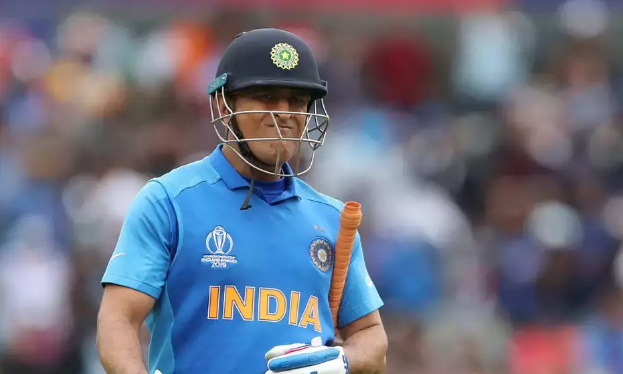Hope MS Dhoni’s Waning Sense of Timing Doesn’t Fail Him in His Retirement Call | On the Ball

MS Dhoni didn’t have the worst ICC World Cup 2019 going by just stats alone -- 273 runs @ 45.50 and a strike-rate of 87.78, as opposed to career numbers of 50.57 and 87.56 respectively. Statistics, however, convey only half the tale.
MS Dhoni has been nothing if not unconventional. He emerged from the cricketing outpost of Ranchi, strong and muscular with a flowing mane, uncomplicated and uninhibited, unawed by the glitz and razzmatazz even while he was taking his first, tiny but hardly tentative steps towards superstardom. His batting was unfettered and unorthodox, grace sacrificed at the altar of effectiveness, his wicket-keeping hardly mirroring the coaching manual but still taking glovework to ethereal levels. In a cricketing landscape of straight lines, Dhoni was the refreshing mish-mash who quietly screamed ‘Watch me.’
And watched him, the cricketing world has now for nearly a decade and a half. Not just watched him, actually, so much as marveled at him. At his ability to finish off chases with spectacular nonchalance. At his innovation and agility behind the sticks. At his calmness under pressure. At his adroitness at reading situations, reading people, reading the game better than most who have played it. At the supreme privacy he has managed despite being in the most public of spaces. At his propensity to surprise, as if to tell people, ‘You might think you know me, but do you really know me at all’?
The legend of Dhoni has grown over the years. The flowing mane is but a distant memory, the generous flecks of grey both in the crop and his stubble increasingly conspicuous. They are reminders that time doesn’t stand still for anyone, not even for Mahendra Singh Dhoni. But it isn’t these reminders, stark as they are, that are startling. After all, they are cosmetic. Maskable.
Also Read | ICC World Cup: England Win. New Zealand Win. Cricket Loses Via Rulebook Farce
Not so the reminders that are increasingly beginning to impose themselves on the playing field. Even today, despite so many miles in the legs, the aura of Dhoni is unmistakable. Whether he is standing behind the stumps, directing traffic and gently instructing bowlers, or in front of it, eyes narrowed and bat poised, he still commands undivided attention.
The promise of a slice of magic as a spinner lures a batsman out of the safety of his crease, or of a resounding, stadium-clearing thwack with six needed for victory off the last ball, still hangs thick in the air. But where this promise was once translated into reality eight times out of ten with the bat, the numbers are now beginning to exchange places. As they will.
It isn’t that Dhoni is no longer the master finisher he once used to be that is surprising. It is, that it has taken so long for that enviable, rare ability to wane. In so many ways, it’s an overwhelming tribute to Dhoni that, at 38, he is expected to pull off the same heroics he did with extraordinary felicity when he was 28. Or even 32.
Which begs the question – if Dhoni at 38 is understandably but nevertheless a less intimidating version of even Dhoni at 37, then isn’t it time to look beyond? Isn’t it time to celebrate the glorious past, yes, but also plan for the future by utilizing the path of the present? Why are we so reluctant to bell the cat when it comes to our heroes? Why is questioning their place blasphemous, motivated, unbecoming, unpopular, personal?
Also Read | International Cricket Establishment’s Anti Expansion Drive, An Inside Story
Virat Kohli and Ravi Shastri were convinced in the last two years leading up to the World Cup that their plans for the sport’s most prestigious prize could not be firmed up without the influential, impactful presence of the man who led India to the World T20 title in 2007, the World Cup in 2011 and the Champions Trophy in 2013. They were happy to overlook his diminishing ball-striking powers because of everything else he brought with him – his willingness to not just help but take over from Kohli at critical stages of the game, his uncanny understanding of the ground realities, his impeccable judgement of the Decision Review System (DRS) appeals process, the wealth of experience he was eager to share with his younger colleagues, his wisdom, his worldly-wise outlook, his role as a mentor, and the fear factor they believed he still possessed.
Where they definitely missed a trick in the immediacy of Dhoni resigning the limited-overs captaincy was in not ascribing him the troubled No. 4 position. Had the think-tank elevated him to the two-drop slot in 2017, it would have given Dhoni two years to grow into and master that position; it would have encouraged him to control the innings more meaningfully and defined the roles of players like Kedar Jadhav and Hardik Pandya, maybe even Ravindra Jadeja, more clearly.
By keeping him at 6 and even 7, they were forcing Dhoni to walk in to spin, get himself in a bind, and then be wary of playing the big shots, aware both that he had to make balls faced count and that there was scarcely any batting worth the name behind him. You’d think someone with 350 ODIs under his belt would have worked all this out, but that’s easier said than done. If anything, oppositions have worked out better how to bowl at Dhoni 2.0, and the limitations – his own and of the batting group below him – have played into their hands.
On the face of it, Dhoni didn’t have the worst World Cup. His 273 runs came at an average of 45.50 and a strike-rate of 87.78, as opposed to career numbers of 50.57 and 87.56 respectively. Statistics, however, convey only half the tale. They don’t reveal his supreme go-slow against Afghanistan – 28 off 52 deliveries despite the circumstances and the conditions were unflattering – or against England and West Indies, against both of whom he only caught up with the strike-rate with last-over pyrotechnics.
Behind the stumps, and especially standing back to the quicks, Dhoni wasn’t at his very best – not just because he conceded 24 byes – though he repeatedly reiterated that to spin, he is still in a league of his own. So, where does that leave us?
Also Read | The Inevitable Loss That Hit Indian Cricket Team at ICC World Cup Semis
Among the things to consider, respectfully, are: Is Dhoni the player still indispensable? And, is what is best for Dhoni best for Indian cricket? The honest answer to both is a resounding ‘No’. He will be well past 39 at the next big event, the T20 World Cup in Australia in October-November 2020, and while age might just be a number, its effects are already clear to see.
To expect Dhoni to retire, and therefore make the job of the deciding authorities easier, is silly and unfair. Retirement is an entirely personal choice; it is not for anyone to dictate when X or Y should call it a day. Matters of selection, however, lie in the hands of those tasked with such responsibilities, though it doesn’t help when one member of the Committee of Administrators proclaims publicly after the World Cup that Dhoni still ‘has a lot of cricket left in him’.
Honestly, I never thought the day would come when we would debate Dhoni’s future. This was the man who retired from Test cricket in the middle of a series, who relinquished the white-ball captaincy without warning. He was the one who oversaw two phases of transition in his first four years as Test skipper. Who shook up the established order, rang out the old and ring in the new. The master of timing, beyond the batting sense. He is still good, very good even sometimes. But all good things must come to an end, at some stage or the other.
(Kaushik is a veteran cricket writer who has reported on over 100 Tests. He co-authored VVS Laxman's autobiography '281 and Beyond')
Get the latest reports & analysis with people's perspective on Protests, movements & deep analytical videos, discussions of the current affairs in your Telegram app. Subscribe to NewsClick's Telegram channel & get Real-Time updates on stories, as they get published on our website.
























